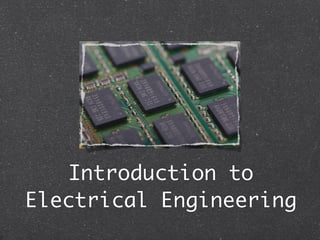
Introduction To Electrical Engineering
- 2. Goal To introduce the fundamental concepts that govern the principles and practices of electrical and electronics engineering.
- 3. Electron ‣ Negatively charged particle, revolves around nucleus of an atom. Electrons are repelled by other electrons. Absence of electron (hole) attracts electrons. Like charges repel, opposites attracts.
- 4. Static vs. Current ELectricity ‣ Static Electricity ‣ Charge does not flow. ‣ Current Electricity ‣ Charge flows along a conductor. ‣ Conventional Current Wisdom: Flows from higher potential to lower potential. ‣ Electron Flow Reality: Electrons are repelled by negative charge and attracted to positive charge.
- 5. Conductor vs. Insulator ‣ Conductor: Allows electrons to flow. ‣ Copper Wire ‣ Insulator: Prevents electrons from flowing. ‣ Rubber ‣ Semiconductors behave as both. ‣ Silicon
- 6. The EE Basics ‣ Voltage (V) ‣ Electric “pressure” or potential difference between two points. ‣ Must exist for current to flow. ‣ Volts - e.g. 2.5V ‣ Ground is nominally 0V, serves as a reference voltage. ‣ Current (I) ‣ Rate of electrons flowing. ‣ Amperes or Amps - e.g. 5A
- 7. The EE Basics ‣ Resistance (R) ‣ Measure of how much a material impedes current flow. ‣ Ohms - e.g. 500KΩ ‣ Power (W) ‣ Measures the rate at which energy is consumed. ‣ Watts - e.g. 5mW
- 8. Direct vs. Alternating Current ‣ Direct Current (VDC) ‣ Current flows in one direction. ‣ Alternating Current (VAC) ‣ Current periodically changes direction. Frequency Amplitude Phase
- 9. Series vs. Parallel Circuits Series Current has only one path to flow from source to ground. Current around a series circuit is the same, voltage across each element varies based on its resistance. Parallel Current has multiple paths to return to ground. Voltage across parallel components is the same, current through each components varies based on its resistance.
- 10. Calculating Resistor Value for an LED We want to add a Light Emitting Diode to our circuit. What size resistor do we add in series to the LED for it to operate safely?
- 11. Find the “givens”: Battery or Source Voltage Vf or Forward Operating Voltage of the LED. Imax or maximum current of the LED. Both found in spec sheets. For our example assume: Vbattery = 5V Vf = 1.7V Imax = 20mA
- 12. Vbattery = 5V Vf = 0.7V Imax = 20mA Ohm’s Law R = V / I R = (Vbattery - Vf) / Imax R = (5V - 1.7V) / .02A R = 165 Ω Reality is you will NOT find a 165 Ω. So find the next LARGER value and use that. For our solution, 180 Ω resistors are fairly common.
- 13. Resistor value is HALF the story. We must also ensure the proper POWER RATING. If we do not allow for the correct power dissipation, component could catch fire! Power = Voltage x Current From last slide, resistor will have to drop 3.3V and pass 20mA of current. Power (Watts) = 3.3V x .02A Power = 66mW
- 14. Again, you will not find a resistor rated for 66mW. Look for the next larger value, typically 1/4W or 250mW is readily available. So for our solution, we will need to acquire a 180Ω resistor rated at 250mW.
- 15. Questions?
Editor's Notes
- \n
- \n
- \n
- \n
- \n
- \n
- \n
- \n
- \n
- \n
- \n
- \n
- \n
- \n
- \n
